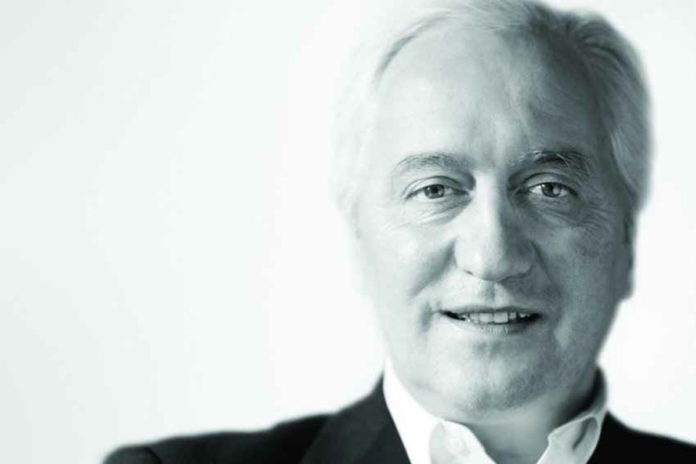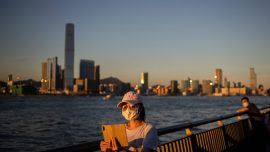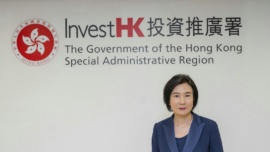A worldwide leader in city planning based on imagination and creative change, Charles Landry points out the shortcomings in the MSAR’s development, it’s segmentation of purpose and steps to overcome it, and proposes shaping a resilient and sustainable urban framework that is both profitable and provides adequately for its citizens’ needs and happiness.
How do you see the current situation in Macau?
Macau of course is being ambitious, as we well know. It’s trying to create a metro, it’s creating a university, doing all the casino stuff and so on. But I’m just saying: is that a big enough ambition for a city that wants to be on the global stage?
Is making casinos the same as making a city? So for example one of my phrases is ‘a strip is not a street’. Casinos by definition want to sort of get you in there into a timeless zone and absorb you completely in that; which is very different from how we normally define a city, which is a place of interaction and where streets and micro-parks and all of that become very important, because you’re trying to encourage civic life.
What are the steps necessary for Macau to evolve?
The issue they should ask themselves – and you can’t just sort of get a white knight to come out of the sky and do it – is really to put on the agenda simply a question – What makes a great city? What are the qualities of a great city?
We’ve [last year] had the UN summit called Habitat III on this question, and they produced a document called ‘The City We Need’.
Now that was agreed on by 15,000 people around the world, including commercial people – the businesses were involved – all types of entities were involved in these meetings that involved 15,000 people and I moderated the one in Germany.
If you’ve got a city where rich and poor are too divided, that tends to create a problem. All of this we know.
So finding ways of mixing populations, even though people might want to always be in their enclaves, it’s better to go in that direction. So my view on the steps is initially, there needs to be an advocacy process, and the fact that you are interviewing me now is part of that advocacy process.
How does inclusion create sustainability?
Now the importance is the population’s inclusion in the planning process. Of course we can exclude them, but the point is – does that create a problem later? Now that raises an issue from the political point of view for a politician and others – do you want to make your citizens happy or do you just want to treat them like subjects?
Now all over the world, because of the way capitalism is developing, it tends to divide rich and poor. All you’re doing is storing up problems if you don’t get some sort of involvement. And involvement of people and organizations tends to make the result more sustainable. If someone was involved in the decision it’s less an issue for them, then, to complain.
So over the world in general, people are finding it more resilient-making to involve people in the way that the city is shaped.
I’ve [recently] been to the Biennale in Venice, which was the architectural Biennale. The whole Biennale in Venice is vast and it was all about this theme – that we need innovative solutions to that.
This is a movement that is happening worldwide because people think that a very limited process of, let’s say, only letting the property developer decide how a city should work, is seen not to be good enough. So you can ask the question: Are property developers good city makers?
They know how to make money out of a project because it’s very easy to make money out of a project if you’ve got the sky, if you can just build into the air and nobody’s costing the air.
So the point I’m making is that getting partnerships between the different actors that tend to get solutions that ultimately are better, is more difficult than just saying: ‘Well who cares about these people’ and just doing it.
But the point is you can make a profit in one building – that’s capital – but if the capital – social capital, creative capital, heritage capital – is being lost, then you could say the balance of the project might be negative. It might be very profitable in terms of the physical structure, but a loss on all the other things. So this wider definition of capital might be quite important.
Would you put property developers and business owners in the same category within that?
No, because I think that they’re different. There are of course enlightened property developers and enlightened businesses. What one needs to get them on to is a higher agenda, a sort of agenda which I’m saying is a bigger ambition. What makes Macau a great city? If you start with that point – what makes a great city and what could you contribute to making a great city that is fit for all – then you begin to open up a debate about things like – which areas should be protected and how high should we go?
So I’m always trying to get them to see, and this is one of my slogans – is this a city of projects or is the city the project? Because once you say the city is the project and my development within that fits that, you’re priorities might shift.
What are the elements that create a sustainable, efficient urban area?
Perhaps some of the streets in old Macau need pedestrianizing in some way, so people can interact. Historically the street is really where people connect with each other – some people they know well, some they know less well.
But that creates the weft and woe of the city. Which comes back to my point about the casino area, which is not a city – it’s a series of isolated projects that, from a visitor’s point of view might look pretty spectacular. The Venetian is obviously a spectacular thing in its own way. But ‘is there more to a city than shops and gambling?’ is what one is really asking.
So one of the things I said is – you’ve already got some nice green lungs in the city, these micro-parks and so on – the more of those the better sort of thing.
If you think of the cities you like, anywhere in the world, you’re partly answering that question about elements that create a sustainable, efficient, urban area. It’s places to hang out. The world is changing dramatically – we don’t want to be in corporate offices, we want to work in third spaces – so lots of third spaces. And what I’ve noticed in Macau is there’s hardly anywhere where you can sit semi-outside and semi-inside. It’s as if it’s forbidden to have seating outside a building.
How does the tourist factor affect everything?
In Venice we precisely discussed that – that point about what is the vision for Venice, where there are 27 million tourists and 50,000 inhabitants.
What they were saying there is – it’s so difficult.
In the case of Venice, you have to manage them. Now what does management mean? It’s quite difficult. In the Venice case it’s slightly easier – you try to deflect them to other areas of interest. So one of the things is trying to create more areas of interest so they are not all focusing on the same point.
That’s one thing.
In the end, this is one of the biggest dilemmas of city making around the world, which there’s no simple solution to.
In terms of Venice, what people were saying is talking about creative tourism. So getting tourists to be more engaged during activities with locals, being more involved with them. Like in the case of Venice, learning various things and skills that Venice is famous for. So you’re trying to get them to get involved with the residents in some way – getting to know them, somehow creating a connection with them.
Also, in a way – you know A-Ma Temple – I went there, you couldn’t really get in. There are in other places – in Japan when you visit Kyoto gardens sometimes you have to, before you visit a place like that, they force you to get your mind focused on it, so that you’re going into what is essentially a spiritual place with the right attitude.
So there’s one of the best gardens in Kyoto called Saihō-ji which is the moss garden. When you go in, you have to register for a start, and when you go in, you have to do a sort of mental exercise for half an hour before you then go into the garden. Whereas up in A-Ma you just go in – and I obviously watched people – take a photo within three seconds, walk past, then go up, then rush down back into the carriage.
You’re limiting the audience and you’re forcing them, to some extent, to respect the essence of what this place is about.
So Saihō-ji, it might be extreme, but it’s leading the way in that sort of thinking. But basically you’ve got to deflect the tourists and get them more engaged and actually perhaps limit. And it’s going to be quite difficult in public spaces, but in A-Ma it’s probably easier.
Is it feasible to actually limit the amount of tourists – either in each venue or in Macau as a whole?
It’s going to be very difficult because obviously the casinos want more and more people to come in. The debate in Venice was that, to some extent, they have to pay more to come in. Obviously they’re paying for stuff in the casinos, but in the Venice case there was getting beyond tourism taxes in the sense of hotel taxes, and effectively giving them a pass. And that pass would do various things, so it doesn’t feel like you’re going into a theme park, but you might get free transport for it, and other services.
Just finding more sophisticated ways of getting a contribution from the tourist to help regenerate the city. So it’s trying to create an income stream.
One of the things that Macau needs is a greater start-up culture, incubation-type places. I know everybody says there’s no space. When I wandered around from the Portas do Cerco back into town, you could see lots of spaces that could be re-thought. There’s lots of opportunities.
In the worst case, you could have about 50 containers which people work in. There’s a place called Container City in London, and I think there’s one in New York.
Within the start-up culture and development of young entrepreneurs, do you think that the tech focus is a good thing, or should there be more diversity?
I think there needs to be more diversity. My own view is that I find it astonishing when the Wynn casino [was built] – I don’t know what it cost, US$3 billion or whatever it cost to build – there should be a commitment from the casino world where there are apps obviously to do with gaming and tourism; but there’s also a hell of a lot of their stuff that is sophisticated animation which has wide potential. That could go from an invention that could also be applied to health, or something.
Many of the experiential things that they’re creating.
Now I feel that that sector, the gambling sector, should have a commitment to feedback, so that the learning system can make much more richer possibilities, because everything we know is about experience, but experience isn’t only about consumption.
Lots of resources should come from the gaming sector because they’re buying most of their stuff from, I don’t know, Silicone Valley and China. There should be some sort of interaction between the local population and the innovation system, which should not only be focused on apps for the gaming industry.
In regards to building a ‘smart city’, how close to that are we, based upon your 1.0, 2.0, 3.0 framework?
1.0 was very much hardware focused – let’s get the basic infrastructure in. Then 2.0 was more consultative and a bit more glamorous, star architects and so on.
I think that Macau obviously has features of 2.0 because whatever you think of the casino strip, it’s sort of, at one level, incredibly interesting in a mad way. In some way it’s sort of quite spectacular, we have to admit that. So I don’t want to say it’s not spectacular, because every time I go I’m always trying to look at the latest casino etc. But obviously it’s an enclosed world.
So I would say Macau is basically 1.0 thinking, but with strong elements of 2.0, less the element of 2.0 which is being a bit more consultative, the 2.0 that is more about understanding the creative economy and all of that.
3.0 is more a sort of city that is co-created, interactive, blending in a modern way the participatory side.
So I think the question is really having an ambition, and I don’t like using the word ‘vision’, but just having a picture of the city that you want: What is this picture? What does it look like? What does it feel like for the different actors in there?
And in that, you might only be able to say ‘we need to raise this debate, we need to really think about this’, because collectively you in Macau, if you were open about it all, could come up with some solutions.
In Macau and Hong Kong we have a very unique situation, relating to one of the main relationships you have spoken about for urban development – balance of power between city and state. How do you perceive the balance of power between city and state that we have here?
That’s a difficult question because you are both city and state. Your state is probably the Chinese government in that sense, because in reality that is the state, even though you’re a city-state.
In relation to European cities or the rest of the world, this thing I’m talking about was one of the central issues of Habitat III in the UN summit. The states have the authority, the legal system and all of that and global relations, but the city has more legitimacy to make the changes that we might need. If you want to become a more green city, it’s much easier to do that at a city level than at a state level. So the city is a better implementer of the things that we require. So the city is a better actor because a city mayor has to deliver normally. With the mayor of New York or wherever the city is, the citizens are asking: ‘Have you cleaned up the garbage? Have you done this, have you done that?’
I think that in the case of Macau, Macau having a vision – again I don’t like the word – but a picture of ambition to make a great city, is something that could help the Chinese government. Macau trying to be a bit of a model.
Macau has so much money in comparison to European cities, so it could really be a green model, it could be a testing ground, it could be all of those things – at least it has the resources. But what you need is property development and ownership and all of these people to understand that this is something that ultimately benefits them.
It might seem initially – ‘hey this all costs money’ – but in the end it will make the city more profitable if you see it in a wider sense; particularly if you’re looking at the happiness, or the self-satisfaction of people as a whole.
























